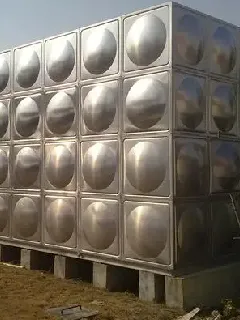loading...
- No. 9, Xingyuan South Street, Dongwaihuan Road, Zaoqiang County, Hengshui, Hebei, China
- admin@zjcomposites.com
- +86 15097380338
- Welcome to visit our website!
Alternatives to Sectional Water Tanks for Efficient Water Storage Solutions
Understanding Sectional Water Tanks A Practical Solution for Water Storage
Water is an essential resource for life, industry, and agriculture. With increasing urbanization and a growing demand for clean water, efficient water storage solutions have become imperative. Sectional water tanks stand out as a practical choice for both residential and industrial applications. This article delves into the features, benefits, and considerations of sectional water tanks.
What are Sectional Water Tanks?
Sectional water tanks are modular storage systems designed to hold large volumes of water. They are typically constructed from materials such as fiberglass, polyethylene, or galvanized steel. These tanks are made up of separate panels or sections that can be assembled on-site to create a unified tank. This design allows for customized sizes and configurations to meet specific water storage needs.
Advantages of Sectional Water Tanks
1. Space Efficiency One of the main advantages of sectional water tanks is their ability to be constructed in confined spaces. Because they are assembled from panels, they can fit into areas where traditional tanks may not. This is especially beneficial in urban settings where space is at a premium.
2. Customizable Sizes Sectional water tanks can be tailored to meet varying volume requirements. Customers can choose from a range of capacities, making them suitable for a wide array of applications, from small residential needs to large-scale industrial projects.
3. Easy Installation The modular nature of sectional tanks allows for easy transport and quick installation. Since the tanks are assembled on-site, they are less cumbersome than single-piece tanks, which can be challenging to move and install.
4. Durability and Longevity Sectional water tanks are designed to withstand harsh environmental conditions. High-quality materials ensure resistance to corrosion, UV radiation, and other damaging factors, leading to a longer lifespan.
5. Cost-Effectiveness While the initial investment may vary depending on material choice and tank size, sectional tanks often provide a cost-effective solution when considering their longevity and low maintenance needs. Additionally, the ability to expand the system by adding sections can further enhance their value.
6. Quality of Water Many sectional water tanks come with advanced features that help maintain the quality of stored water. Insulation and food-grade materials can prevent contamination and maintain appropriate temperatures, ensuring water remains safe for consumption.
Applications of Sectional Water Tanks
Sectional water tanks are versatile and find applications across various sectors, including
sectional water tanks

- Residential Use Homeowners utilize sectional tanks for domestic water storage, rainwater harvesting systems, and irrigation. Their customizability allows homeowners to select sizes that fit their specific needs.
- Commercial Buildings Businesses often require large volumes of water for operations. Sectional tanks serve as effective solutions for restaurants, hotels, and office buildings, providing a reliable supply of water for various purposes.
- Industrial Sector Industries such as manufacturing, agriculture, and mining benefit from sectional water tanks for process water, fire protection, and irrigation needs. Their robust design ensures they can handle the rigorous demands of industrial environments.
- Emergency Water Supply Sectional water tanks can be used as temporary or emergency water supply systems during natural disasters or droughts. Their ease of assembly allows for rapid deployment in critical situations.
Considerations When Choosing Sectional Water Tanks
When selecting a sectional water tank, several factors should be taken into account
1. Material The choice of material affects the tank's durability, water quality, and maintenance requirements. Always choose materials that meet industry standards and are appropriate for the intended use.
2. Capacity and Size Assess your specific water storage needs to determine the appropriate size and capacity for the tank. Consider future growth requirements as well.
3. Installation and Maintenance Ensure you have a qualified team for installation and that you understand the maintenance requirements to keep the tank in optimal condition.
4. Regulatory Compliance Depending on your location, there might be regulations governing water storage systems. Ensure that the tank complies with local laws and standards.
Conclusion
Sectional water tanks offer a flexible and efficient solution for various water storage needs. Their adaptability, durability, and cost-effectiveness make them a preferred option for both residential and industrial applications. By considering the specific requirements and selecting the right tank, users can ensure a reliable and sustainable water supply, contributing positively to resource management in diverse settings. As we continue to face challenges related to water scarcity and quality, the importance of intelligent water storage solutions like sectional tanks will only grow.
-
GRP Structures: The Future of Lightweight, High-Performance EngineeringNewsJun.20,2025
-
FRP Water Tank: High-Performance Storage for Corrosive and Clean Water SystemsNewsJun.20,2025
-
FRP Square Tube: The New Industry Standard for Chemical and Structural ApplicationsNewsJun.20,2025
-
FRP Pultruded Profiles: The Ultimate Choice for Lightweight Structural StrengthNewsJun.20,2025
-
FRP Handrails: The Safer, Smarter, and Stronger Choice for Modern InfrastructureNewsJun.20,2025
-
FRP Grating: The Smart Solution for Durable, Lightweight Industrial FlooringNewsJun.20,2025
-
Why Choose a Galvanized Water Tank for Your Storage NeedsNewsMay.21,2025
